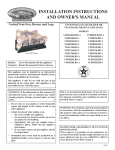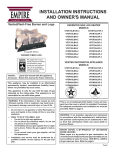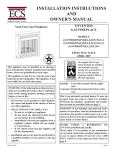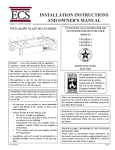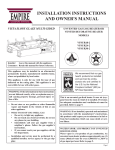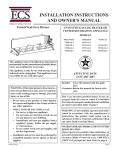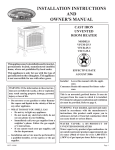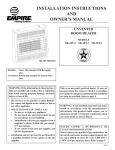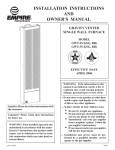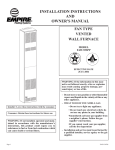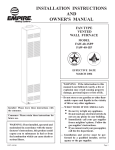Download White Mountain P)-1 Owner`s manual
Transcript
INSTALLATION INSTRUCTIONS AND OWNER'S MANUAL Vented/Vent-Free Burner and Logs UNVENTED GAS LOG HEATER OR VENTED DECORATIVE APPLIANCE MODELS VFDR18LB(N,P)-1 VFDR24LB(N,P)-1 VFDR30LB(N,P)-1 This appliance may be installed in an aftermarket permanently located, manufactured (mobile) home, where not prohibited by local codes. This appliance is only for use with the type of gas indicated on the rating plate. This appliance is not convertible for use with other gases. WARNING: If the information in these instructions are not followed exactly, a fire or explosion may result causing property damage, personal injury or loss of life. — Do not store or use gasoline or other flammable vapors and liquids in the vicinity of this or any other appliance. — WHAT TO DO IF YOU SMELL GAS • Do not try to light any appliance. • Do not touch any electrical switch; do not use any phone in your building. • Immediately call your gas supplier from a neighbor’s phone. Follow the gas supplier’s instructions. • If you cannot reach your gas supplier, call the fire department. — Installation and service must be performed by a qualified installer, service agency or the gas supplier. 21565-3-0906 EFFECTIVE DATE SEPTEMBER 2006 Installer: Leave this manual with the appliance. Consumer: Retain this manual for future reference. This is an unvented gas-fired heater. It uses air (oxygen) from the room in which it is installed. Provisions for adequate combustion and ventilation air must be provided. Refer to page 7. WARNING: If not installed, operated and maintained in accordance with the manufacturer's instructions, this product could expose you to substances in fuel or from fuel combustion which can cause death or serious illness. WATER VAPOR: A BY-PRODUCT OF UNVENTED ROOM HEATERS Water vapor is a by-product of gas combustion. An unvented room heater produces approximately one (1) ounce (30ml) of water for every 1,000 BTU's (.3KW's) of gas input per hour. Refer to page 6. Page 1 TABLE OF CONTENTS SECTION PAGE IMPORTANT SAFETY INFORMATION ........................................................................................ 3 SAFETY INFORMATION FOR USERS OF LP-GAS..................................................................... 4 INTRODUCTION ............................................................................................................................. 5 GENERAL INFORMATION ............................................................................................................ 6 WATER VAPOR: A BY-PRODUCT OF UNVENTED ROOM HEATERS ..................................... 6 PROVISIONS FOR ADEQUATE COMBUSTION & VENTILATION AIR .................................. 7 CLEARANCES ............................................................................................................................7 - 8 COMBUSTIBLE MATERIAL .......................................................................................................... 9 FIREPLACE PREPARATION .......................................................................................................... 9 INSTALLING AS A VENTED APPLIANCE ................................................................................. 10 BEFORE FULLY INSTALLING THE APPLIANCE ..................................................................... 10 GAS SUPPLY .................................................................................................................................. 11 VFDR(18,24) LOG PLACEMENT (5 LOG SET) .......................................................................... 12 VFDR30 LOG PLACEMENT (7 LOG SET).................................................................................. 13 OPERATION INSTRUCTIONS/FLAME APPEARANCE ............................................................ 14 WIRING........................................................................................................................................... 15 VFDR(18,24,30)LB LIGHTING INSTRUCTIONS ....................................................................... 16 PILOT FLAME CHARACTERISTICS .......................................................................................... 17 CLEANING AND SERVICING...................................................................................................... 18 TROUBLESHOOTING - SYMPTOMS, POSSIBLE CAUSES AND CORRECTIONS .............. 19 PARTS LIST .................................................................................................................................... 20 PARTS VIEW .................................................................................................................................. 21 HOW TO ORDER REPAIR PARTS ............................................................................................... 21 SERVICE NOTES ......................................................................................................................22-23 Page 2 21565-3-0906 IMPORTANT SAFETY INFORMATION • An unvented room heater having an input rating of more than 6,000 Btu per hour shall not be installed in a bathroom • An unvented room heater having an input rating of more than 10,000 Btu per hour shall not be installed in a bedroom or bathroom. • Never burn solid fuels in a fireplace where a gas log set is installed. • Due to high temperatures, the appliance should be located out of traffic and away from furniture and draperies. • Do not place clothing or other flammable material on or near the appliance. • Children and adults should be alerted to the hazards of high surface temperature and should stay away to avoid burns or clothing ignition. • Young children should be carefully supervised when they are in the same room as the appliance. • This unit complies with ANSI Z21.11.2 Unvented Heaters and it also complies with ANSI Z21.60 Decorative Vented Appliances for Solid Fuel Burning Fireplaces. State or local codes may only allow operation of this appliance in a vented configuration. Check your state or local codes. • Correct installation of logs, proper location of the heater and annual cleaning are necessary to avoid potential problems with sooting. Sooting, resulting from improper installation or operation, can settle on surfaces outside the fireplace. • Avoid any drafts that could alter burner flame patterns. Do not allow fans to blow directly into the fireplace. Do not place a blower inside burn box area of firebox. Ceiling fans may create drafts that alter burner flame patterns. Sooting and improper burning will occur as a result of drafts. • WARNING: Do not allow fans to blow directly into the fireplace. Avoid any drafts that alter burner flame patterns. • WARNING: Do not use a blower insert, heat exchanger insert or other accessory not approved for use with this heater. • Periodic examination and cleaning of the venting system of the solid-fuel burning fireplace, including frequency of such examination WARNING When used without adequate combustion and ventilation air, heater may give off CARBON MONOXIDE, an odorless, poisonous gas. Do not install heater until all necessary provisions are made for combustion and ventilation air. Consult the written instructions provided with the heater for information concerning combustion and ventilation air. In the absence of instructions, refer to the National Fuel Gas Code, ANSI Z223.1, Section 5.3 or applicable local codes. This heater is equipped with a PILOT LIGHT SAFETY SYSTEM designed to turn off the heater if not enough fresh air is available. DO NOT TAMPER WITH PILOT LIGHT SAFETY SYSTEM! If heater shuts off, do not relight until you provide fresh air. If heater keeps shutting off, have it serviced. Keep burner and control compartment clean. 21565-3-0906 and cleaning, by a qualified agency. • The installation must conform with local codes or, in the absence of local codes, with the National Fuel Gas Code, ANSI Z223.1/ NFPA54. • NOTE: Installation and repair should be done by a qualified service person. The appliance should be inspected before use and at least annually by a qualified service person. More frequent cleaning may be required due to excessive lint from carpeting, bedding material, etc. It is imperative that the control compartment, burners and circulating air passageways of the appliance be kept clean. • Any safety screen or guard removed for servicing an appliance must be replaced prior to operating the appliance. Provide adequate combustion and ventilation air. • The flow of combustion and ventilation air MUST NOT be obstructed. • Provide adequate clearances around air openings into the combustion chamber and adequate accessibility clearance for servicing and proper operation. NEVER obstruct the front opening of the appliance. • An unvented room heater intended for installation in a solid-fuel burning fireplace shall comply with the following instructions. • A fireplace screen must be in place when the appliance is operating and, unless other provisions for combustion air are provided, the screen shall have an opening(s) for introduction of combustion air. • Solid-fuels shall not be burned in a masonry or UL 127 factory-built fireplace in which an unvented room heater is installed. • Any glass doors shall be fully opened when the appliance is in operation. • Any outside air ducts and/or ash dumps in the fireplace shall be permanently closed at time of appliance installation. • WARNING: Failure to keep the primary air opening(s) of the burner(s) clean may result in sooting and property damage. • WARNING: Before installing in a solid-fuel burning fireplace, the chimney flue and firebox must be cleaned of soot, creosote, ashes and loose paint by a qualified chimney cleaner. CARBON MONOXIDE POISONING MAY LEAD TO DEATH. Early signs of carbon monoxide poisoning resemble the flu, with headache, dizziness and/or nausea. If you have these signs, heater may not be working properly. Get fresh air at once! Have heater serviced. Some people – pregnant women, persons with heart or lung disease, anemia, those under the influence of alcohol, those at high altitudes – are more affected by carbon monoxide than others. The pilot light safety system senses the depletion of oxygen at its location. If this heater is installed in a structure having a high vertical dimension, the possibility exists that the oxygen supply at the higher levels will be less than that at the heater. In this type of application, a fan to circulate the structure air will minimize this effect. The use of this fan will also improve the comfort level in the structure. When a fan is used to circulate air, it should be located so that the air flow is not directed at the burner. Page 3 SAFETY INFORMATION FOR USERS OF LP-GAS Propane (LP-Gas) is a flammable gas which can cause fires and explosions. In its natural state, propane is odorless and colorless. You may not know all the following safety precautions which can protect both you and your family from an accident. Read them carefully now, then review them point by point with the members of your household. Someday when there may not be a minute to lose, everyone's safety will depend on knowing exactly what to do. If, after reading the following information, you feel you still need more information, please contact your gas supplier. LP-GAS WARNING ODOR If a gas leak happens, you should be able to smell the gas because of the odorant put in the LP-Gas. That's your signal to go into immediate action! • Do not operate electric switches, light matches, use your phone. Do not do anything that could ignite the gas. • Get everyone out of the building, vehicle, trailer, or area. Do that IMMEDIATELY. • Close all gas tank or cylinder supply valves. • LP-Gas is heavier than air and may settle in low areas such as basements. When you have reason to suspect a gas leak, keep out of basements and other low areas. Stay out until firefighters declare them to be safe. • Use your neighbor's phone and call a trained LP-Gas service person and the fire department. Even though you may not continue to smell gas, do not turn on the gas again. Do not re-enter the building, vehicle, trailer, or area. • Finally, let the service man and firefighters check for escaped gas. Have them air out the area before you return. Properly trained LP-Gas service people should repair the leak, then check and relight the gas appliance for you. NO ODOR DETECTED - ODOR FADE Some people cannot smell well. Some people cannot smell the odor of the chemical put into the gas. You must find out if you can smell the odorant in propane. Smoking can decrease your ability to smell. Being around an odor for a time can affect your sensitivity or ability to detect that odor. Sometimes other odors in the area mask the gas odor. People may not smell the gas odor or their minds are on something else. Thinking about smelling a gas odor can make it easier to smell. The odorant in LP-gas is colorless, and it can fade under some circumstances. For example, if there is an underground leak, the movement of the gas through soil can filter the odorant. Odorants in LP-Gas also are subject to oxidation. This fading can occur if there is rust inside the storage tank or in iron gas pipes. The odorant in escaped gas can adsorb or absorb onto or into walls, masonry and other materials and fabrics in a room. That will take some of the odorant out of the gas, reducing its odor intensity. LP-Gas may stratify in a closed area, and the odor intensity could vary at different levels. Since it is heavier than air, there may be more odor at lower levels. Always be sensitive to the slightest gas odor. If you detect any odor, treat it as a serious leak. Immediately go into action as instructed earlier. SOME POINTS TO REMEMBER • Learn to recognize the odor of LP-gas. Your local LP-Gas Dealer can give you a "Scratch and Sniff" pamphlet. Use it to find out what the propane odor smells like. If you suspect that your LP-Gas has a weak or abnormal odor, call your LP-Gas Dealer. • If you are not qualified, do not light pilot lights, perform service, or make adjustments to appliances on the LP-Gas system. If you are qualified, consciously think about the odor of LP-Gas prior to and while lighting pilot lights or performing service or making adjustments. • Sometimes a basement or a closed-up house has a musty smell that can cover up the LP-Gas odor. Do not try to light pilot lights, perform service, or make adjustments in an area where the conditions are such that you may not detect the odor if there has been a leak of LP-Gas. • Odor fade, due to oxidation by rust or adsorption on walls of new cylinders and tanks, is possible. Therefore, people should be particularly alert and careful when new tanks or cylinders are placed in service. Odor fade can occur in new tanks, or Page 4 reinstalled old tanks, if they are filled and allowed to set too long before refilling. Cylinders and tanks which have been out of service for a time may develop internal rust which will cause odor fade. If such conditions are suspected to exist, a periodic sniff test of the gas is advisable. If you have any question about the gas odor, call your LP-gas dealer. A periodic sniff test of the LP-gas is a good safety measure under any condition. • If, at any time, you do not smell the LP-Gas odorant and you think you should, assume you have a leak. Then take the same immediate action recommended above for the occasion when you do detect the odorized LP-Gas. • If you experience a complete "gas out," (the container is under no vapor pressure), turn the tank valve off immediately. If the container valve is left on, the container may draw in some air through openings such as pilot light orifices. If this occurs, some new internal rusting could occur. If the valve is left open, then treat the container as a new tank. Always be sure your container is under vapor pressure by turning it off at the container before it goes completely empty or having it refilled before it is completely empty. 21565-3-0906 INTRODUCTIONS IMPORTANT: Read all instructions carefully before starting installation. Failure to follow these installation instructions may result in a possible fire hazard and will void the warranty. Save this manual for future reference. Please read this manual before installing and using the appliance. Instructions to Installer 1. Installer must leave instruction manual with owner after installation. 2. Installer must have owner fill out and mail warranty card supplied with unvented room heater/vented decorative appliance. 3. Installer should show owner how to start and operate unvented room heater/vented decorative appliance. Always consult your local Building Department regarding regulations, codes or ordinances which apply to the installation of an unvented room heater/vented decorative appliance. This appliance may be installed in an aftermarket* manufactured (mobile) home, where not prohibited by state or local codes. *Aftermarket: Completion of sale, not for purpose of resale, from the manufacturer. This appliance is only for use with the type of gas indicated on the rating plate. This appliance is not convertible for use with other gases. Solid-fuels shall not be burned in a fireplace where a vented decorative appliance is installed. A vented decorative appliance must be installed only in a solidfuel burning fireplace with a working flue and constructed of noncombustible material. Any alteration of the original design, installed other than as shown in these instructions or use with a type of gas not shown on the rating plate is the responsibility of the person and company making the change. Important All correspondence should refer to complete Model Number, Serial Number and type of gas. Attention: During initial use of log you will detect an odor as the log is cured. Regulator Pressure Setting Gas Inlet Pressure Maximum Minimum Model VFDR18LBN VFDR18LBP VFDR24LBN VFDR24LBP VFDR30LBN VFDR30LBP 21565-3-0906 Notice: During initial firing of this unit, its paint will bake out, and smoke will occur. To prevent triggering of smoke alarms, ventilate the room in which the unit is installed. WARNING: This appliance is for installation only in a solidfuel burning masonry or UL 127 factory-built fireplace or in a listed ventless firebox enclosure. It has been design certified for these installations. Exception: DO NOT install this appliance in a factory-built fireplace that includes instructions stating it has not been tested or should not be used with unvented gas logs. WARNING: Any modification to this unvented gas heater or its controls can be dangerous. Improper installation or use of the heater can cause serious injury or death from fire, burns, explosion or carbon monoxide poisoning. Well Head Gas Installations Some natural gas utilities use "well head" gas. This may affect the Btu output of the unit. Contact the gas company for the heating value. Contact the manufacturer or your gas company before changing spud/orifice size. ACCESSORIES Description EK-1 Embers Kit PE-20 Platinum Embers ELH-1 Fireplace Hood for Vent-Free Logs ELH-2 Fireplace Hood for Vent-Free Logs FRBC FRBTC FREC FWS TRW TMV Color Black Brass Battery Operated Remote Control Battery Operated Remote Control with Thermostat Electric Remote Control Wall Switch Remote Wall Thermostat Wall Thermostat, Millivolt - Reed Switch Gas PRODUCT SPECIFICATIONS Natural Gas (Millivolt) 3.5" W.C. 10.5" W.C. 5.0" W.C. Valve Type Natural Propane Natural Propane Natural Propane Millivolt Millivolt Millivolt Millivolt Millivolt Millivolt Propane Gas (Millivolt) 10.0" W.C. 13.0" W.C. 11.0" W.C. Btu/hr. Btu/hr. Max. Rate Min. Rate 28,000 19,000 28,000 22,000 34,000 24,000 34,000 26,000 40,000 27,000 40,000 31,000 Page 5 GENERAL INFORMATION This is an unvented gas-fired heater. It uses air (oxygen) from the room in which it is installed. Provisions for adequate combustion and ventilation air must be provided. Keep room area clear and free from combustible materials, gasoline and other flammable vapors and liquids. Unvented gas heaters are a supplemental zone heater. They are not intended to be a primary heating appliance. Water vapor produced by an unvented heater can create moisture problems in a home when operated for extended periods of time. During manufacturing, fabricating and shipping, various components of this appliance are treated with certain oils, films or bonding agents. These chemicals are not harmful but may produce annoying smoke and smells as they are burned off during the initial operation of the appliance; possibly causing headaches or eye or lung irritation. This is a normal and temporary occurrence. The initial break-in operation should last 2-3 hours with the burner at the highest setting. Provide maximum ventilation by opening windows or doors to allow odors to dissipate. Any odors remaining after this initial break-in period will be slight and will disappear with continued use. This appliance must not be used with glass doors in the closed position. This can lead to pilot outages and severe sooting outside the fireplace. Do not use this room heater if any part has been under water. Immediately call a qualified service technician to inspect the room heater and replace any part of the control system and any gas control which has been under water. WARNING: This appliance is equipped for (natural or propane) gas. Field conversion is not permitted. • Plastic bag containing glowing embers (rock wool) for burner coverage. This millivolt controlled heater may be operated with optional devices for REMOTE/OFF/ON functions. a. Wall switch or thermostat with wire. b. Hand held remote control with ON/OFF switch or thermostat. Handle the gas log burner assembly by the grate and legs only. Do not pick the unit up by the burner. Gloves are recommended when handling logs to prevent skin irritation. Logs are fragile - Handle with care. Qualified Installing Agency Installation and replacement of gas piping, gas utilization equipment or accessories and repair and servicing of equipment shall be performed only by a qualified agency. The term "qualified agency" means any individual, firm, corporation, or company that either in person or through a representative is engaged in and is responsible for (a) the installation, testing, or replacement of gas piping or (b) the connection, installation, testing, repair, or servicing of equipment; that is experienced in such work; that is familiar with all precautions required, and that has complied with all the requirements of the authority having jurisdiction. State of Massachusetts: The installation must be made by a licensed plumber or gas fitter in the Commonwealth of Massachusetts. Sellers of unvented propane or natural gas-fired supplemental room heaters shall provide to each purchaser a copy of 527 CMR-30 upon sale of the unit. In the State of Massachusetts, unvented propane and natural gas-fired space heaters shall be prohibited in bedrooms and bathrooms. Before you get started Carefully inspect the contents for shipping damage. If any parts are missing or damaged, immediately inform the dealer from whom you purchased the appliance. Do not attempt to install any part of the appliance unless you have all parts in good condition. The installation must conform with local codes or, in the absence of local codes, with the National Fuel Gas Code, ANSI Z223.1.* Make sure you have received all parts: Check your packing list to verify that all listed parts have been received. You should have the following: • Gas log grate/burner assembly. • Two (2) masonry anchoring screws and two (2) 10 x 1/2" black sheet metal anchoring screws. • Ceramic Log Set - (5 Piece on VFDR(18,24), (7 piece on VFDR30) High Altitude When installing this unit at an elevation above 2,000 feet (in the United States), it may be necessary to decrease the input rating by changing the existing burner orifice to a smaller size. Generally, input should be reduced 4 percent for each 1,000 feet above sea level. However, if the heating value of the gas has been reduced, this general rule may not apply. Check with local gas utility for proper orifice size identification. *Available from the American National Standards Institute, Inc. 11 West 42nd St., New York, N.Y. 10018. WATER VAPOR: A BY-PRODUCT OF UNVENTED ROOM HEATERS Water vapor is a by-product of gas combustion. An unvented room heater produces approximately one (1) ounce (30ml) of water for every 1,000 BTU's (.3KW's) of gas input per hour. Unvented room heaters must be used as supplemental heat (a room) rather than a primary heat source (an entire house). In most supplemental heat applications, the water vapor does not create a problem. In most applications, the water vapor enhances the low humidity atmosphere experienced during cold weather. Page 6 The following steps will help insure that water vapor does not become a problem. 1. Be sure the heater is sized properly for the application, including ample combustion air and circulation air. 2. If high humidity is experienced, a dehumidifier may be used to help lower the water vapor content of the air. 3. Do not use an unvented room heater as the primary heat source (an entire house). 21565-3-0906 PROVISIONS FOR ADEQUATE COMBUSTION & VENTILATION AIR This heater shall not be installed in a confined space unless provisions are provided for adequate combustion and ventilation air. ventilation air by one of the methods described in the National Fuel Gas Code, ANSI Z223.1, Section 5.3. or applicable local codes. The National Fuel Gas Code defines a confined space as a space whose volume is less than 50 cubic feet per 1,000 Btu per hour (4.8m3 per kw) of the aggregate input rating of all appliances installed in that space and an unconfined space as a space whose volume is not less than 50 cubic feet per 1,000 Btu per hour (4.8 m3 per kw) of the aggregate input rating of all appliances installed in that space. Rooms communicating directly with the space in which the appliances are installed, through openings not furnished with doors, are considered a part of the unconfined space. Unusually Tight Construction The air that leaks around doors and windows may provide enough fresh air for combustion and ventilation. However, in buildings of unusually tight construction, you must provide additional fresh air. Unusually tight construction is defined as construction where: a. Walls and ceilings exposed to the outside atmosphere have a continuous water vapor retarder with a rating of one perm or less with openings gasketed or sealed, and b. Weather-stripping has been added on openable windows and doors, and c. Caulking or sealants are applied to areas such as joints around window and door frames, between sole plates and floors, between wall-ceiling joints, between wall panels, at penetrations for plumbing, electrical, and gas lines, and at other openings. If your home meets all of the three criteria above, you must provide additional fresh air. Warning: If the area in which the heater may be operated is smaller than that defined as an unconfined space or if the building is of unusually tight construction, provide adequate combustion and Example of Large Room with 1/2 Wall divider. Figure 1 The following formula can be used to determine the maximum heater rating per the definition of unconfined space: (L1 + L2)FT x (W)FT x (H)FT x 1000 50 If the area in which the heater may be operated is smaller than that defined as an unconfined space, provide adequate combustion and ventilation air by one of the methods described in the National Fuel Gas Code, ANSI Z223.1, Section 5.3. Adhere to all codes, or in their absence, the latest edition of THE NATIONAL FUEL GAS CODE ANSI Z223.1 or NFPA54 which can be obtained from: Btu/Hr = American National Standards Institute National Fire Protection Association, Inc. 11 West 42nd St. Batterymarch Park New York, NY 10018 Quincy, MA 02269 CLEARANCES Minimum Dimensions For Solid Fuel Burning Fireplaces UL127 Factory Built Fireplaces (Figure 2) Model VFDR18 VFDR24 VFDR30 A 17" 23" 26" B 12" 12" 12" C 28" 30" 34" D 17" 18" 20" The dimensions shown and defined in the fireplace manufacturer’s instructions are minimum clearances to maintain in installing this heater. Left and right clearances are determined when facing the front of the heater. Glass Doors Make sure that glass doors are open during all operations of the logset. The opening of the glass door frame should be the dimension used for the minimum front opening of the firebox. Follow these instructions to ensure safe installation. Figure 2 Failure to follow instructions exactly can create a fire hazard. 21565-3-0906 Page 7 CLEARANCES (continued) Sidewall & Ceiling Clearances (Figure 3) 18”, 24”, 30” Log Non-Combustible Material Distance Requirements for Safe Installation 12" or more Non-combustible material Less than 12" Non-combustible material must be extended to at least 8" with the installation of the optional fireplace hood. If you cannot extend non-combustible material at least 8", you must operate heater with flue damper open. 41” Mantel Clearances with Hood (Figure 5) You must have non-combustible materials above the fireplace opening. Non-combustible material must extend at least 8" above fireplace opening. With sheet metal, you must have non-combustible material behind it. 6” Figure 3 Heat resistant materials such as slate and marble must be at least 1/2" thick. Sheet metal should not be installed onto combustible material. The sides of the fireplace opening must be 6" from any combustible wall. The ceiling must be at least 41" (for 18", 24" and 30" logs) from the fireplace opening. Example: A mantel may project from the wall a maximum of 2" at a minimum of 13-1/2" above the opening, and a maximum of 6" at a minimum of 15" above the opening. Mantel Clearances Without Hood (Figure 4) You must have non-combustible materials above the fireplace opening. Non-combustible material must extend at least 12" above fireplace opening. With sheet metal, you must have noncombustible material behind it. Heat resistant materials such as slate and marble must be at least 1/2" thick. Sheet metal should not be installed onto combustible material. 8” Mantel 6” Mantel 4” Mantel 2” Mantel HEAT RESISTANT MATERIAL 8” WITH HOOD 16.0” 14.25” 15.0” 13.5” 10” and less Mantel HOOD HEAT RESISTANT MATERIAL 12” WITHOUT HOOD 28” HEATER IN FIREPLACE OR FIREBOX 12” Figure 5 HEATER IN FIREPLACE OR FIREBOX Figure 4 If your installation does not meet the above minimum clearances, you must proceed to one of the following steps: • Operate the heater with the flue damper open. See page 10 for Installing as a Vented Appliance. • Raise the mantel to the proper height. • Remove the mantel. Floor Clearance (Figure 6) If installing heater at floor level, the minimum distance to combustibles is “0” inches. If your installation does not meet the above clearances, you must proceed to one of the following steps: • Use a hood • Operate the heater with flue damper open. See page 10 for Installing as a Vented Appliance. • Raise the mantel to the proper height. • Remove the mantel. Figure 6 Page 8 21565-3-0906 COMBUSTIBLE MATERIAL Do not attach combustible material to the mantel of your fireplace. This is a fire hazard. No greeting card, stockings or ornamentation of any type should be placed on or attached to the fireplace. This is a heating appliance. The flow of heat can ignite combustibles. Figure 7 Figure 8 FIREPLACE PREPARATION • Turn off gas supply to fireplace or firebox. • Have the fireplace floor and chimney professionally cleaned to remove ashes, soot, creosote or other obstructions. Have this cleaning performed annually after installation. • Seal any fresh air vents or ash clean-out doors located on floor or wall of fireplace. If not, drafting may cause pilot outage or sooting. Use a heat-resistant sealant. Do not seal chimney flue damper. Install and operate the appliance as directed in this manual. FOR MASONRY BUILT FIREPLACES FREE OPENING AREA OF CHIMNEY DAMPER FOR VENTING COMBUSTION PRODUCTS FROM DECORATIVE APPLIANCES FOR INSTALLATION IN SOLID FUEL BURNING FIREPLACES Appliance Input Rate (BTU/hr) 20 Appliance Input Rate (BTU/hr) 20 30 40 Minimum Opening** (sq. in.) Chimney Height* (ft) 40 Minimum Opening** (sq. in.) Chimney Height* (ft) FOR FACTORY BUILT FIREPLACES FREE OPENING AREA OF CHIMNEY DAMPER FOR VENTING COMBUSTION PRODUCTS FROM DECORATIVE APPLIANCES FOR INSTALLATION IN SOLID FUEL BURNING FIREPLACES 30 6 17.6 25.7 33.8 8 16.5 23.7 31.2 10 15.1 21.7 28.7 15 14.1 19.9 26.1 20 12.9 18.5 23.7 30 12.2 16.9 21.6 * 10 11.3 16.6 22.1 15 8.6 12.6 17.3 20 7.5 10.8 14.5 25 6.6 9.6 12.6 30 6.2 9.1 11.3 35 5.7 8.0 10.8 40 5.3 7.5 10.2 Height is from hearth to top of chimney and the minimum height is 6 feet. ** Chart shows minimum opening (sq. in.) for given height and input rate. * Height is from hearth to top of chimney and the minimum height is 10 feet. ** Chart shows minimum opening (sq. in.) for given height and input rate. 21565-3-0906 Page 9 INSTALLING AS A VENTED APPLIANCE Notice (Damper Clamp Installation) When installing your log set as a vented installation the damper clamp must be used. When installing your log set as a vent-free installation the damper clamp can be used to eliminate the potential for odors when burning the logs for the first time. Installing Damper Clamp (Figure 9) Remove all ashes or other debris from the fireplace. If the fireplace is equipped with an ash dump be sure to seal the door with furnace cement or high temperature silicone. Be sure to check the damper for proper operation and verify that the flue passageway is open. Place the clamp over the lip of the damper and tighten the hold down bolt until the clamp is securely attached to the damper. This will prevent the damper from accidentally closing. Manual and millivolt controlled gas logs may be installed as a vented decorative log set in compliance with ANSI Z21.60 and National Fuel Gas Code. When the gas logs are operated with the damper open, non-combustible material and minimum mantel requirements do not apply. Figure 9 BEFORE FULLY INSTALLING THE APPLIANCE • Turn off the gas supply to the fireplace or firebox. • Seal any fresh air vents and/or ash clean-out doors located on the floor or wall of the fireplace. If left unsealed, drafting may cause pilot outage or sooting. Use a heat resistant sealant. Do not seal the chimney flue damper. Before installing in a solid fuel burning fireplace, the chimney flue and firebox must be cleaned of soot, creosote, ashes and loose paint by a qualified chimney cleaner. You must secure the gas log heater to the fireplace floor. If not, the entire unit may move when you adjust the controls. Movement of unit may cause shifting of the gas logs which leads to sooting and improper burning. Grate movement could cause a gas leak. Special care is required if you are installing the unit into a sunken fireplace. You must raise the fireplace floor to allow access to gas log controls. This will insure adequate air flow and guard against sooting. Raise the fireplace floor using noncombustible materials. Assembly Procedure: (Figure 10) 1. Center the gas log unit in the fireplace or firebox. Make certain the front feet of the grate sit inside the front edge of the fireplace or firebox. 2. An anchor hole is provided in the two bottom side members of the grate frame. After centering the grate correctly, mark the hole positions on the fireplace/firebox floor. Drill two (2) 5/32" diameter holes approximately 1-1/2" deep for masonry screws or 1/8" hole for sheet metal screws. 3. Anchor the grate to the fireplace/firebox floor using the screws provided. Refer to Figure 10. Proper installation of the grate is essential to prevent any movement of the gas logs and controls during operation. ANCHOR SCREW LOCATIONS Figure 10 Page 10 21565-3-0906 GAS SUPPLY Check all local codes for requirements, especially for the size and type of gas supply line required. Recommended Gas Pipe Diameter Pipe Length Schedule 40 Pipe Tubing, Type L Inside Diameter Outside Diameter Nat. L.P. Nat. L.P. 0-10 feet 1/2” 3/8” 1/2” 3/8” 0-3 meters 12.7mm 9.5mm 12.7mm 9.5mm 10-40 feet 1/2” 1/2” 5/8” 1/2” 4-12 meters 12.7mm 12.7mm 15.9mm 12.7mm 40-100 feet 1/2” 1/2” 3/4” 1/2” 13-30 meters 12.7mm 12.7mm 19mm 12.7mm 100-150 feet 3/4” 1/2” 7/8” 3/4” 31-46 meters 19mm 12.7mm 22.2mm 19mm Note: Never use plastic pipe. Check to confirm whether your local codes allow copper tubing or galvanized. Note: Since some municipalities have additional local codes, it is always best to consult your local authority and installation code. Installing a New Main Gas Cock Each appliance should have its own manual gas cock. A manual main gas cock should be located in the vicinity of the unit. Where none exists, or where its size or location is not adequate, contact your local authorized installer for installation or relocation. Compounds used on threaded joints of gas piping shall be resistant to the action of liquefied petroleum gases. The gas lines must be checked for leaks by the installer. This should be done with a soap solution watching for bubbles on all exposed connections, and if unexposed, a pressure test should be made. Never use an exposed flame to check for leaks. Appliance must be disconnected from piping at inlet of control valve and pipe capped or plugged for pressure test. Never pressure test with appliance connected; control valve will sustain damage! A gas valve and ground joint union should be installed in the gas line upstream of the gas control to aid in servicing. It is required by the National Fuel Gas Code that a drip line be installed near the gas inlet. This should consist of a vertical length of pipe tee connected into the gas line that is capped on the bottom in which condensation and foreign particles may collect. 21565-3-0906 Figure 11 The use of the following gas connectors is recommended: — ANS Z21.24 Appliance Connectors of Corrugated Metal Tubing and Fittings — ANS Z21.45 Assembled Flexible Appliance Connectors of Other Than All-Metal Construction The above connectors may be used if acceptable by the authority having jurisdiction. The state of Massachusetts requires that a flexible appliance connector cannot exceed three feet in length. Pressure Testing of the Gas Supply System 1. To check the inlet pressure to the gas valve, a 1/8" (3.175mm) N.P.T. plugged tapping, accessible for test gauge connection, must be placed immediately upstream of the gas supply connection to the appliance. 2. The appliance and its individual shutoff valve must be disconnected from the gas supply piping system during any pressure testing of that system at test pressures in excess of 1/2 psig (3.5 kPa). 3. The appliance must be isolated from the gas supply piping system by closing its individual manual shutoff valve during any pressure testing of the gas supply piping system at test pressures equal to or less than 1/2 psig (3.5 kPa). Attention! If one of the procedures results in pressures in excess of 1/2 psig (14" w.c.) (3.5 kPa) on the appliance gas valve, it will result in a hazardous condition. Page 11 VFDR(18,24) LOG PLACEMENT (5 LOG SET) Before you begin: if you are installing logs onto the VFDR18 or VFDR24 models, this burner assembly is supplied with a set of five ceramic fiber logs. Do not handle these logs with your bare hands! Always wear gloves to prevent skin irritation from ceramic fibers. After handling logs, wash your hands gently with soap and water to remove any traces of fibers. The positioning of the logs is critical to the safe and clean operation of this burner assembly. Sooting and other problems may result if the logs are not properly and firmly positioned on the burner assembly. Refer to Figure 12 and Figure 13 and corresponding WARNING: when completing following log placement instructions. 1. Place front logs (#1 and #2) between front grate flange and main burner. Align notches on front logs with locator tabs in base. 2. Place middle log (#3) between front and rear loop of burner. Note: Do not place log on top of pilot assembly. 3. Place rear log (#4) on rear log shelf. Bottom flange of log must be placed between the log shelf and burner tube. 4. Place front twig (#5) onto (#1) log and flat area on (#3) log. The bottom of the front twig is to be placed behind the grate tang that is second from the left. EMBER MATERIAL PLACEMENT ON BURNER 5. After all logs are positioned properly, apply Rockwool ember material to the front burner port area. To apply, carefully separate the ember material into small amounts no larger than "dime size" pieces. Fluffed up pieces one layer thick on top of the burner generally works best, and will provide the best ember glow. Do not place ember material more than one layer thick. No more than (2) two small packets of ember material (part no. 15998) evenly placed on the burner, is recommended on VFDR18 and VFDR24 models. Using additional ember material will decrease the amount of ember glow effect. Extra ember material should be saved for future ember applications as necessary. See Figure 13. 5 4 3 2 1 Figure 12 WARNING: Failure to position the parts in accordance with this diagram or failure to use only parts specifically approved with this appliance may result in property damage or personal injury. Attention: Do not use Figure 12 or Figure 13 to order logs. Refer to parts list on page 20 and parts view on page 21 to order logs and/or ember material for your appropriate model. EMBER MATERIAL PLACEMENT (SHADED AREA ONLY) Figure 13 Page 12 21565-3-0906 VFDR30 LOG PLACEMENT (7 LOG SET) Before you begin: If you are installing logs onto the VFDR30 model, this burner assembly place is supplied with a set of seven ceramic fiber logs. Do not handle these logs with your bare hands. Always wear gloves to prevent skin irritation from ceramic fibers. After handling logs, wash your hands gently with soap and water to remove any traces of fiber. The positioning of logs is critical to safe and clean operation of this burner assembly. Sooting and other problems may result if the logs are not properly and firmly positioned on the burner assembly. Refer to Figure 14 and Figure 15 and corresponding WARNING: when completing following log placement steps. 1. Place front logs (#1, #2, and #3) between grates and main burner. Align notches on front logs with locator tabs in base. 2. Place middle log (#4) between front and rear loop of burner. Note: do not place on top of pilot assembly. 3. Place rear log (#5) on rear log shelf. Bottom flange is to be placed between the log shelf and burner tube. 4. Place bottom front twig (#6) onto flat areas of middle log (#4) and bottom end of front twig to the back side of the grate tang (4th one from the left). 5. Place the rear twig (#7) onto flat area of rear log (#5) and over the front of the front twig. 6 5 7 4 3 1 2 Figure 14 Warning: Failure to position the parts in accordance with this diagram or failure to use only parts specifically approved with this appliance may result in property damage or personal injury. Attention: Do not use Figure 14 or Figure 15 to order logs. Refer to parts list on page 20 and parts view on page 21 to order logs and/or ember material. Ember Material Placement on Burner 6. After all logs are properly positioned, place small "dime" size pieces of Rockwool lightly across the front burner tube ports. Place the ember material (Rockwool pieces) side by side. Do not stack more than one layer of embers across the burner ports. No more than (1) one packet of ember material (part number 15999) evenly placed on the burner, is recommended on VFDR30 models. See Figure 15. EMBER MATERIAL PLACEMENT (SHADED AREA ONLY) Figure 15 21565-3-0906 Page 13 OPERATION INSTRUCTIONS/FLAME APPEARANCE Flames from the pilot (rear right back side of the pan burner) as well as the main flame should be visually checked as the log set is installed. PILOT ASSEMBLY BURNER TUBE In normal operation at full rate, the flame appearance should be sets of yellow flames above the rear burner section, and shorter blue flames with glowing embers on the front burner section. NOTE: all flames will be random by design, flame height will go up and down. Avoid any drafts that alter burner flame patterns. Do not allow fans to blow directly into fireplace. Do not place a blower inside the burner area of the firebox. Ceiling fans may create drafts that alter flame patterns. Sooting and improper burning will result. During manufacturing, fabricating and shipping, various components of this appliance are treated with certain oils, films or bonding agents. These chemicals are not harmful, but may produce annoying smoke and smells as they are burned off during the initial operation of the appliance, possibly causing headaches or eye or lung irritation. This is a normal and temporary occurrence. PIEZO IGNITOR ON/OFF/REMOTE SWITCH VALVE PRESSURE TEST PORT ACCESS HOLES HI/LO CONTROL KNOB ON/OFF/PILOT CONTROL KNOB Millivolt - Figure 16 The initial break-in operation should last 2-3 hours with the burner at the highest setting. Provide maximum ventilation by opening windows or doors to allow odors to dissipate. Any odors remaining after this initial break-in will be slight and will disappear with continued use. Page 14 21565-3-0906 WIRING burner assembly. Thermostats are not approved on vented decorative appliances. On circulating vent-free firebox, install remote control receiver behind bottom louver. Label all wires prior to disconnection when servicing controls. Wiring errors can cause improper and dangerous operation. Verify proper operation after servicing. Refer to remote control installation and operating instructions for more details on remote control. 18", 24" and 30" Gas Logs (Millivolt) thermopile is self powered gas valve and does not require 110 volts. See Figure 17 to provide optional wall switch, thermostat, or remote control. Maximum length of 20 feet of 16 AWG to conductor wires is to be used with all optional switches. 750 Millivolt System When you ignite the pilot, the thermocouple produces millivolts (electrical current) which energizes the magnet in the gas valve. After 30 seconds to 1 minute time period you can release the gas control knob and the pilot will stay ON. Allow your pilot flame to operate an additional one (1) to two (2) minutes before you turn the gas control knob from the PILOT position to the ON position. This time period allows the millivolts (electrical current) to buildup to a sufficient level allowing the gas control to operate properly. Check System Operation Millivolt system and all individual components may be checked with a millivolt meter 0-1000 MV range. Remote Receiver Use the following steps to place the remote receiver adjacent to the gas valve. Millivolt Control The valve regulator controls the burner pressure which should be checked at the pressure test point. Turn captured screw counter clockwise 2 or 3 turns and then place tubing to pressure gauge over test point (Use test point “A” closest to control knob). After taking pressure reading, be sure and turn captured screw clockwise firmly to re-seal. Do not over torque. Check for gas leaks. Attention: 1. The remote receiver can not be placed behind the gas valve and burner assembly. 2. When facing the appliance, the remote receiver must be placed to the right of the gas valve and burner assembly. Note: Do not let remote control receiver come in contact with WIRING DIAGRAM H REMOTE CONTROL RECEIVER/ THERMOSTAT/ CONTROLE E DISTANCE DU RECEPTEUR N (OPTIONAL) THERMOSTAT (FACULATIVE) THERMOSTAT (OPTIONAL) WALL SWITCH INTERRUPTEUR MURAL (FACULTATIVE) REMOTE/OFF/ON SWITCH A DISTANCE/OUVERT/ FERME INTERRUPTEUR GAS VALVE VALVE DE GAZ (OPTIONAL) REMOTE CONTROL RECEIVER (FACULTATIVE) CONTROLE E DISTANCE DU RECEPTEUR REMOTE/OFF/ON SWITCH A DISTANCE/FERME/OUVERT INTERRUPTEUR REMOTE OFF ON THERMOPILE PILOT VEILLEUSE THERMOCOUPLE (LPG) GAS VALVE THERMOCOUPLE (NATURAL) IF ANY OF THE ORIGINAL WIRE AS SUPPLIED WITH THIS UNIT MUST BE REPLACED, IT MUST BE REPLACED WITH NUMBER 18, 150°C WIRE OR ITS EQUIVALENT. SI UN DES FILS ELECTRIQUES ORIGINAUX, VENANT DU FABRICANT AVEC CETTE UNITE, DOIT ETRE REMPLACE, VOUS DEVEZ LE REMPLACER AVEC UN FIL ELECTRIQUE DE NUMERO 18, 150 ° C DU L'EQUIVALENT. Figure 17 21565-3-0906 Page 15 VFDR(18,24,30)LB LIGHTING INSTRUCTIONS FOR YOUR SAFETY READ BEFORE LIGHTING WARNING: If you do not follow these instructions exactly, a fire or explosion may result causing property damage, personal injury or loss of life. A. This appliance has a pilot which must be lighted by hand. When lighting the pilot, follow these instructions exactly. B. BEFORE LIGHTING, smell all around the appliance area for gas. Be sure to smell next to the floor because some gas is heavier than air and will settle on the floor. WHAT TO DO IF YOU SMELL GAS • Do not try to light any appliance • Do not touch any electrical switch; Do not use any phone in your building • Immediately call your gas supplier from a neighbor's phone. Follow the gas supplier's instructions. • If you cannot reach your gas supplier, call the fire department. C. Use only your hand to push in or turn the gas control knob. Never use tools. If the knob will not push in or turn by hand, don't try to repair it, call a qualified service technician. Force or attempted repair may result in a fire or explosion. D. Do not use this appliance if any part has been under water. Immediately call a qualified service technician to inspect the appliance and to replace any part of the control system and any gas control which has been under water. LIGHTING INSTRUCTIONS 1. STOP! Read the safety information above on this label. 2. Set REMOTE/OFF/ON switch to "OFF". 3. Turn off all electric power to the appliance (if applicable). 4. Open bottom louver assembly (if applicable). 5. GAS CONTROL KNOB GAS CONTROL KNOB Push in gas control knob slightly GAS CONTROL KNOB SHOWN ININ "OFF" POSITION. SHOWN "OFF" POSITION. SHOWN IN "OFF" POSITION. and turn clockwise to "OFF". REMOTE REMOTE REMOTE NOTE: Knob cannot be turned from "PILOT" OFF OFF OFF ON ON ON to "OFF" unless knob is pushed in slightly. Do not force. 6. Wait ten (10) minutes to clear THERMOPILE THERMOPILE THERMOPILE ELECTRODE ELECTRODE ELECTRODE out any gas. Then smell for gas, including near the floor. If you smell gas, STOP! Follow "B" in the safety information above. If THERMOCOUPLE THERMOCOUPLE THERMOCOUPLE (LPG) (LPG) you do not smell gas, go to the next(LPG) THERMOCOUPLE THERMOCOUPLE THERMOCOUPLE step. (NATURAL) (NATURAL) (NATURAL) 7. PILOT PILOT PILOT 8. Turn gas control knob counterclockwise to "PILOT". 9. Push in control knob all the way and hold in. Repeatedly push the Piezo Ignitor Button until the pilot is lit. Continue to hold the control knob in for about one (1) minute after the pilot is lit. Release knob, and it will pop back up. Pilot should remain lit. If it goes out, repeat steps 5 through 9. • If knob does not pop up when released, STOP and IMMEDIATELY call a qualified service technician or gas supplier. • If the pilot will not stay lit after several tries, turn the gas control knob to "OFF" and call your service technician or gas supplier. 10. Turn gas control knob counterclockwise to "ON". 11. Close bottom louver assembly (if applicable). 12. Turn on all electric power to the appliance (if applicable). 13. Set REMOTE/OFF/ON switch to desired setting. Find pilot - Follow metal tube from gas control. The pilot is located next to the burner, near the right side. TO TURN OFF GAS TO APPLIANCE 1. Set REMOTE/OFF/ON switch to OFF. 4. 2. Turn off all electric power to the appliance if service is to be performed (if applicable). Push in gas control knob slightly and turn clockwise to "OFF". Do not force. 5. Close bottom louver assembly (if applicable). 3. Open bottom louver assembly (if applicable). Page 16 21565-3-0906 PILOT FLAME CHARACTERISTICS Figure 18 shows a correct pilot flame pattern. The correct flame will be blue and will extend beyond the thermocouple. The flame will surround the thermocouple just below the tip. A slight yellow flame may occur where the pilot flame and main burner flame meet. Figure 19 shows an incorrect pilot flame pattern. The incorrect pilot flame is not touching the thermocouple. This will cause the thermocouple to cool. When the thermocouple cools, the heater will shut down. VFDR (Series) PILOT Cleaning and Maintenance/Pilot Oxygen Depletion Sensor Pilot (Figure 20) When the pilot has a large yellow tip flame, clean the Oxygen Depletion Sensor as follows: 1. Clean the ODS pilot by loosening nut B from the pilot tubing. When this procedure is required, grasp nut A with an open end wrench. 2. Blow air pressure through the holes indicated by the arrows. This will blow out foreign materials such as dust, lint and spider webs. Tighten nut B also by grasping nut A. Figure 20 Correct Pilot Flame Pattern Figure 18 Incorrect Pilot Flame Pattern Figure 19 If pilot flame pattern is incorrect, as shown in Figure 19 • See Troubleshooting, page 19. 21565-3-0906 Page 17 CLEANING AND SERVICING Annual inspection and cleaning by your dealer or qualified service technician is recommended to prevent malfunction and/or sooting. TURN OFF HEATER AND ALLOW TO COOL BEFORE CLEANING. Remove logs, handling carefully by holding gently at each end. Gloves are recommended to prevent skin irritation from ceramic fibers. If skin becomes irritated, wash gently with soap and water. Refer to manual for correct log placement. PERIODIC CLEANING – Refer to parts diagram for location of items discussed below. • Do not use cleaning fluid to clean logs or any part of heater. • Logs - brush with soft bristle brush or vacuum with brush attachment. • Remove loose particles and dust from the burner, controls and grate. • Inspect and clean burner air intake hole. Remove lint or particles with brush. Failure to keep air intake hole clean will result in sooting and poor combustion. Page 18 ANNUAL CLEANING/INSPECTION – Refer to parts diagram for location of items discussed below. • • • • • Inspect and clean burner air intake hole. Remove lint or particles with vacuum or brush. Failure to keep air intake hole clean will result in sooting and poor combustion. Inspect and clean all burner ports. Inspect ODS pilot for operation and accumulation of lint at air intake holes. Verify flame pattern and log placement for proper operation. Verify smooth and responsive ignition of main burner. 21565-3-0906 TROUBLESHOOTING SYMPTOMS, POSSIBLE CAUSES AND CORRECTIONS 1. When ignitor button is pressed, there is no spark at ODS/ pilot. a. Ignitor electrode positioned wrong - Replace pilot. b. Ignitor electrode is broken - Replace pilot. c. Ignitor electrode not connected to ignitor cable - Reconnect ignitor cable. d. Ignitor cable pinched or wet. Keep ignitor cable dry - Free ignitor cable if pinched by any metal or tubing. e. Broken ignitor cable - Replace ignitor cable. f. Bad piezo ignitor - Replace piezo ignitor. 2. Appliance produces unwanted odors. a. Appliance burning vapors from paint, hair spray, glues, etc. - Ventilate room. Stop using odor causing products while heater is running. b. Gas leak - Locate and correct all leaks. 3. Appliance shuts off during use. (Pilot and main burner are off.) a. Not enough fresh air is available for ODS/pilot to operate - Open window and/or door for ventilation. b. Low line pressure - Contact local gas company. c. ODS/pilot is partially clogged - Clean ODS/pilot. d. Defective thermocouple - Replace pilot. 4. Appliance shuts off during use. (Pilot stays on.) a. Low line pressure - Check line pressure to the valve. b. Defective thermopile - Check pilot flame, check wire connections, output should be a minimum of 325 millivolts across. TH/TP and TP terminals with REMOTE/OFF/ON switch off. 5. Gas odor even when control knob is in OFF position. a. Gas leak - Locate and correct all leaks. b. Control valve defective - Replace control valve. 6. When ignitor button is pressed, there is spark at ODS/pilot, but no ignition. a. Gas supply turned off or manual shutoff valve closed - Turn on gas supply or open manual shutoff valve. b. Control knob not in PILOT position - Turn control knob to PILOT position. c. Control knob not pressed in while in PILOT position - Press in control knob while in PILOT position. d. Air in gas lines when installed - Continue holding down control knob. Repeat igniting operation until air is removed. e. ODS/pilot is clogged - Replace ODS/pilot assembly or get it serviced. f. Gas regulator setting is not correct - Replace gas regulator. 7. ODS/pilot lights but flame goes out when control knob is released. a. Control knob not fully pressed in - Press in control knob fully. b. Control knob not pressed in long enough - After ODS/pilot lights, keep control knob pressed in 30 seconds. 8. 9. 10. 11. 12. c. Manual Shutoff valve not fully open - Fully open manual shutoff valve. d. Thermocouple connection loose at control valve - Hand tighten until snug, then tighten 1/4 turn more. e. Pilot flame not touching thermocouple, which allows thermocouple to cool, causing pilot flame to go out. This problem could be caused by either low gas pressure or dirty or partially clogged ODS/pilot - Contact local gas company. f. Thermocouple damaged - Replace thermocouple. g. Control valve damaged - Replace control valve. Burner does not light after ODS/pilot is lit. a. Burner orifice clogged - Clean burner or replace main burner orifice. b. Burner orifice diameter is too small - Replace burner orifice. c. Inlet gas pressure is too low - Contact qualified service person. If burning at main burner orifice occurs (a loud, roaring blow torch noise). a. You must turn off burner assembly and contact a qualified service person. b. Manifold pressure is too low - Contact local gas company. c. Burner orifice clogged - Clean burner or replace burner orifice. Logs appear to smoke after initial operation. a. Vapors from paint or curing process of logs - Problem will stop after a few hours of operation. Run the heater with the damper open if you have one, or open a window for the first few hours. Log heater is intended to be smokeless. Turn OFF heater and call qualified service person. Heater produces a whistling noise when main burner is lit. a. Turning control knob to HIGH position when main burner is cold - Turn control knob to LOW position and let warm up for a minute. b. Air in gas line - Operate burner until air is removed from line. Have gas line checked by local gas company. c. Dirty or partially clogged burner orifice - Clean burner or replace burner orifice. No gas to pilot. a. LP-regulator shut down due to inlet pressure too high Verify LP tank regulator is installed and set at 11" to 13" w.c. Replace regulator on heater. If the gas quality is bad, your pilot may not stay lit, the burners may produce soot and the heater may backfire when lit. If the gas quality or pressure is low, contact your local gas supplier immediately. 21565-3-0906 Page 19 PARTS LIST Attention: When ordering parts, it is very important that part number and description of part coincide. INDEX NO. 1 2 2 3 3 4 5 6 7 8 9 10 10 11 12 12 13 14 15 16 17 18 18 19 20 21 22 23 24 25 26 27 28 29 30 31 32 33 N/S N/S PART NUMBERS VFDR18LB VFDR24LB 21588 21588 R3623 R3623 R3624 R3624 21590 21590 21591 21591 R9022 R9023 21592 21592 R7624 R7624 R7572 R7572 21669 21670 21581 21581 P285 P244 P258 P210 P212 P212 21561 21561 21559 21559 R7063 R7063 21560 21560 21562 R2423 21589 R3626 R3625 R9028 R9027 21585 21578 R2313 R3436 R3435 R5668 R7587 R7586 R7585 R7554 R7588 15998 - 21563 R2423 21589 R3626 R3625 R9028 R9027 21586 21579 R2313 R3436 R3435 R5668 R7556 R7555 R7553 R7554 R7557 15998 - VFDR30LB 21588 R3623 R3624 21590 21591 R9024 21260 R7624 R7572 21671 21581 P296 P297 P212 21561 21559 R7063 21560 21564 R2423 21589 R3626 R3625 R9028 R9027 21587 21580 R2313 R3436 R3435 R5668 R7598 R7597 R7553 R7554 R7601 R7599 R7600 15999 DESCRIPTION PILOT SHIELD (NAT ONLY) PILOT ASSEMBLY (LPG) PILOT ASSEMBLY (NAT) PILOT BRACKET (LPG) PILOT BRACKET (NAT) BURNER, TUBE BRACKET, LOG LOCATOR AIR SHUTTER JAMB NUT BURNER BASE SUB-ASSEMBLY LEG, REAR (2 REQUIRED) ORIFICE (NAT) ORIFICE (LPG) ORIFICE HOLDER TUBING ASSEMBLY (VALVE TO PILOT - LPG) TUBING ASSEMBLY (REGULATOR TO PILOT - NAT) REGULATOR, NAT PILOT TUBING ASSEMBLY (VALVE TO REGULATOR - NAT ONLY) TUBING ASSEMBLY CONNECTOR, MALE VALVE BRACKET (2 REQUIRED) VALVE (NAT) VALVE (LPG) KNOB, EXTENSION ON/OFF KNOB, EXTENSION HI/LO COVER PLATE, FRONT LEG, FRONT IGNITOR, PIEZO SWITCH, REMOTE/OFF/ON WIRE ASSEMBLY (ON/OFF/REMOTE) IGNITER WIRE REAR LOG MIDDLE LOG FRONT LOG, LEFT FRONT LOG, RIGHT FRONT LOG, MIDDLE FRONT TWIG REAR TWIG ROCKWOOL (EMBER MATERIAL) (2REQUIRED) ROCKWOOL (EMBER MATERIAL) USE ONLY MANUFACTURER'S REPLACEMENT PARTS. USE OF ANY OTHER PARTS COULD CAUSE INJURY OR DEATH. Page 20 21565-3-0906 PARTS VIEW 1 1 2 2 3 3 5 5 4 6 7 6 7 8 12 9 10 11 17 8 12 13 14 25 26 16 10 11 22 18 23 25 26 21 15 16 17 19 20 13 14 9 21 15 18 4 22 19 20 23 24 18” BURNER 24 24” BURNER 27 32 28 30 29 5 PIECE LOG SET 1 2 3 4 5 27 8 6 7 28 33 12 13 32 14 25 26 9 10 11 17 30” BURNER 29 22 19 20 18 30 21 15 16 23 24 31 7 PIECE LOG SET HOW TO ORDER REPAIR PARTS Parts can be ordered only through your service person or dealer. For best results, the service person or dealer should order parts through the distributor. Parts can be shipped directly to the service person/dealer. All parts listed in the Parts List have a Part Number. When ordering parts, first obtain the Model Number from the name plate on your equipment. Then determine the Part Number (not the Index Number) and the Description of each part from the following appropriate illustration and list. Be sure to give all this information . . . Appliance Number Part Description Appliance Serial Number Part Number Type of Gas (Propane or Natural) Do not order bolts, screws, washers or nuts. They are standard hardware items and can be purchased at any local hardware store. Shipments contingent upon strikes, fires and all causes beyond our control. 21565-3-0906 Empire Comfort Systems, Inc. Nine Eighteen Freeburg Ave. Belleville, Illinois 62222-0529 Page 21 SERVICE NOTES Page 22 21565-3-0906 SERVICE NOTES 21565-3-0906 Page 23 Empire Comfort Systems, Inc. 918 Freeburg Ave. Belleville, IL 62220 PH: 618-233-7420 or 800-851-3153 FAX: 618-233-7097 or 800-443-8648 [email protected] www.empirecomfort.com Page 24 21565-3-0906
























